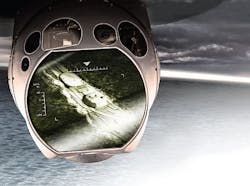Raytheon to establish dedicated software team for unmanned aircraft multi-spectral targeting sensors
Officials of the U.S. Air Force Lifecycle Management Center at Wright-Patterson Air Force Base, Ohio, announced a $12.6 million contract Friday to the Raytheon Space and Airborne Systems segment in McKinney, Texas, for MQ-1 and MQ-9 support.
The job involves establishing a dedicated software team to develop, field, and sustain the Medium Altitude Long Endurance Tactical Multi-Spectral Targeting Systems software line.
Raytheon provides a family of multi-spectral sensors for the Predator and Reaper UAVs. The latest is the AN/DAS-4, the next-generation Raytheon Multi-Spectral Targeting System (MTS).
Compared with its predecessor multi-spectral targeting systems, the AN/AAS-52, AAS-53, ASQ-228, DAS-1 and DAS-2, the DAS-4 offers greater fire control and target location accuracy technology for precise coordinates, Raytheon officials say. Raytheon won a $90 million first-lot production contract from the Air Force in April 2016 for the AN/DAS-4.
The new MTS variant enables mission commanders to use high-definition data from airborne tactical electro-optical sensors to identify and engage targets with much greater accuracy, company officials say.
A multispectral sensor like the DAS-4 and others in the Raytheon MTS family captures image data at specific frequencies across the electromagnetic spectrum, including light from frequencies beyond the visible light range, such as infrared.
Multi-spectral imaging can enable intelligence analysts to extract additional information that the human eye fails to capture with its receptors for red, green and blue. It was originally developed for space-based imaging.
Multi-spectral sensors particularly can be useful in identifying recently disturbed soil that might indicate the presence of hidden improvised explosive devices (IEDs), or the recent passing of military convoys along dirt roads.
The Raytheon AN/DAS-4 offers other major improvements over its predecessors, including: four high-definition cameras covering five spectral bands; a three-color diode pump laser designator and rangefinder; laser spot search and track capability; automated sensor and laser bore sight alignment; and three mode target tracker.
Legacy Predator and Reaper UAVs are fitted with the Raytheon multi-spectral targeting system (MTS-A), which provides real-time imagery selectable between infrared and day TV, as well as a laser designation capability. MQ-1 can employ two laser-guided Hellfire anti-armor missiles with the MTS.
Air Force leaders announced earlier this month that they plan to retire the MQ-1 Predator UAVs next year, and replace them with the MQ-9 Reaper.
As of last year, Raytheon had delivered more than 3,000 systems of the MTS family on a wide range of platforms in addition to the Predator and Reaper UAVS, including helicopters and fixed-wing aircraft. MTS delivers superior performance and reliability at the lowest life-cycle cost.
On Friday's MTS software contract Raytheon will do the work in McKinney, Texas, and should be finished by March 2020. For more information contact Raytheon Space and Airborne Systems online at www.raytheon.com, or the Air Force Lifecycle Management Center at www.wpafb.af.mil/aflcmc.
Learn more: search the Aerospace & Defense Buyer's Guide for companies, new products, press releases, and videos
